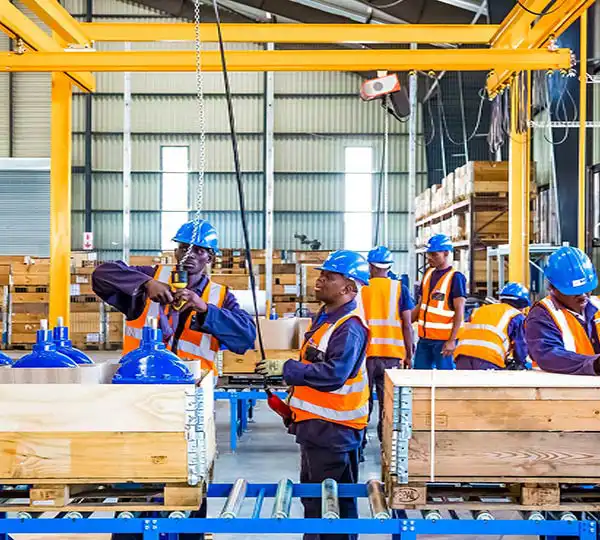
Empowering Employees through In-Plant Training Programmes
According to a study by the Association for Talent Development, companies that offer comprehensive training programmes have 218% higher income per employee than those with less comprehensive training. This statistic underscores the importance of investing in your employees’ growth and development, and one of the most effective ways to do so is through in-plant training.
In-plant training offers hands-on learning opportunities and practical skills development that can help employees feel more confident, engaged, and empowered. From reducing travel costs to customising training to your specific needs, in-plant training offers a range of benefits that can help your business thrive.
In this article, we will explore the concept of employee empowerment through in-plant training and share best practices and strategies for maximising the impact of your training initiatives.
What is In-Plant Training?

In-plant training is a highly effective way for companies to invest in the growth and development of their employees. By providing training and development opportunities right where employees work, companies can help their workforce gain new skills and knowledge and improve their performance.
Analogous to a chef learning new recipes and techniques in their own kitchen, in-plant training offers employees the chance to improve their skills and techniques in their work environment. This can include training on new technology, machinery, software, or procedures to help employees perform their jobs better.
For example, in a manufacturing factory, employees can receive in-plant training on how to operate new machinery or assembly line processes. This training can help improve employee productivity, efficiency, and overall job satisfaction.
In addition, in-plant training programmes can take different forms, from informal lunch-and-learn sessions to more structured and comprehensive programmes. They can be tailored to address specific skill gaps or training needs within the company or can be more broadly focused on improving employee knowledge and capabilities.
Recommended reading: Augmented Intelligence Teams: How AI is Transforming Businesses
How do In-Plant Training Programmes Work?

In-plant training programmes typically involve facilitators coming to a company’s facility to deliver customised training courses for its employees. Here are the major steps involved:
Step 1: Identify Training Needs and Goals
The first step in designing an in-plant training programme is to identify the specific training needs and goals of the company. This can involve reviewing employee performance data, conducting surveys or interviews, and consulting with managers and other stakeholders.
Step 2: Designing the Training Programme
Once the training needs and goals have been identified, the facilitators will work closely with the company to design a customised training programme. This can involve selecting training topics, designing training materials, and determining the delivery method and schedule.
Step 3: Delivering the Training
During the training programme, the facilitators will deliver the training to the employees on-site at the company’s facility. This can involve conducting workshops, seminars, or online courses, depending on the specific needs and goals of the company.
Step 4: One-on-One Support
Besides delivering the training, the facilitators will also provide one-on-one support to the employees to help them apply what they have learned to their work. This can involve coaching, mentoring, or providing feedback on individual projects or assignments.
Recommended reading: The MacTay Open Programme: What You Need to Know
Benefits of In-Plant Training Programmes

In-plant training programmes offer a range of benefits to companies that invest in their employee’s growth and development. Here are some of the major benefits:
- Train multiple employees simultaneously
In-plant training programmes enable companies to train multiple employees at the same time. This is particularly beneficial for companies that have a large workforce or that need to train several employees on the same topic. By training employees together, companies can ensure that everyone receives the same information and is on the same page.
- Eliminate travel costs
By bringing the training to the company’s facility, in-plant training programmes eliminate the need for employees to travel to external training courses. This can help companies save on travel expenses, such as airfare, lodging, and meals, while also reducing the time employees are away from work.
- Reduce time away from work
Because in-plant training programmes take place at the company’s facility, employees can take part in the training while still being available to handle work-related tasks as needed. This minimises the time that employees need to be away from their work, resulting in less disruption to the company’s operations.
- Improved employee retention and loyalty
Investing in employee training and development is a key way to show that a company values its employees. In-plant training programmes can help employees feel more engaged and committed to their work, which can lead to higher retention rates. Employees who feel valued and supported by their employers are also more likely to remain loyal to the company.
- Customised training to your specific needs
In-plant training programmes are highly flexible and can be customised to fit the specific needs and goals of the company. This means that companies can choose the training topics and delivery methods that best align with their goals and culture. By tailoring the training to their specific needs, companies can ensure that employees receive the most relevant and valuable information.
- Stay up-to-date on industry changes and advancements
Industries are constantly evolving, with new technologies and techniques emerging all the time. In-plant training programmes enable companies to stay up-to-date with these changes and advancements, ensuring that employees have the skills and knowledge needed to remain competitive. By staying ahead of industry trends, companies can position themselves as leaders in their field and attract top talent.
Recommended reading: Talent Exodus: How Learning Programmes Can Address Employee Attrition
Best Practices for Designing and Implementing In-Plant Training Programmes

To ensure that in-plant training programmes are practical and beneficial to both the organisation and its employees, it’s essential to follow best practices when designing and implementing the programmes. Here are some of the critical best practices:
- Identify employee training needs
The first step in designing an effective in-plant training programme is to identify the specific training needs of the employees. This can be done through surveys, focus groups, or interviews with employees and supervisors. By understanding the specific training needs of the employees, companies can design training programmes that are relevant and useful.
- Align training with business goals
In-plant training programs should be aligned with the business goals and objectives of the company. This ensures that the training is not only relevant to the employees but also contributes to the overall success of the organisation.
- Create a structured training programme
In-plant training programmes should be structured and organised with clear learning objectives, training materials, and assessment methods. A structured training programme helps ensure all employees receive the same information and training, which can lead to improved consistency and performance.
- Incorporate hands-on learning opportunities
Hands-on learning opportunities, such as simulations, role-playing, and on-the-job training, can be highly effective in in-plant training programmes. These opportunities allow employees to apply the skills and knowledge they’ve learned in a real-world setting, which can improve retention and transfer of learning.
- Provide feedback and coaching
Providing regular feedback and coaching can help employees understand their strengths and weaknesses and identify areas for improvement. This can help employees stay motivated and engaged in the training process and help them make progress towards their learning goals.
- Encourage self-directed learning
In addition to structured training programmes, companies should encourage self-directed learning opportunities for employees. This can include providing access to online courses, books, or other resources that employees can use to continue their learning and development.
- Recognise and reward employees for progress
Recognizing and rewarding employees for their progress and achievements in training can be highly motivating and can help reinforce the importance of training and development. This can be done through formal recognition programmes, such as awards or certificates, or informal recognition, such as verbal praise or additional responsibilities.
- Regularly evaluate and improve training programmes
Finally, in-plant training programmes should be regularly evaluated and improved to ensure their ongoing effectiveness. Companies can use employee feedback, assessment data, and other metrics to identify areas for improvement and make necessary adjustments to the training programme.
Unlock Your Company’s Potential with In-Plant Training
In-plant training offers a unique opportunity to bring professional development directly to your team. By choosing the time and location that works best for you, you can avoid disrupting your business during peak periods of activity.
At MacTay, we prioritise hands-on, practical training that lets your employees apply what they learn immediately. Our interactive and engaging courses are tailored to meet your specific needs and address the challenges unique to your organisation.
Through in-plant training, we can discuss confidential information and situations specific to your company, providing a level of customisation and personalisation that other training programmes simply cannot match. You can rest assured that the topics covered will be relevant and directly applicable to your business.
Beyond the educational benefits, in-plant training can also help foster team spirit and camaraderie. Your staff will learn and grow together under the guidance of experienced and knowledgeable facilitators committed to providing a safe and supportive learning environment.
Ready to take your company to the next level with in-plant training? Simply complete the form, and our team will reach out to you promptly to get started.










